Tension mounted as the 11 artics and their ace drivers
Page 62

Page 63
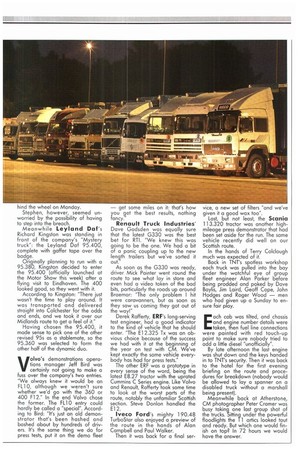
Page 64

Page 65
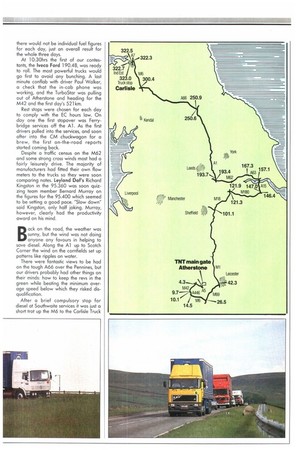
Page 66
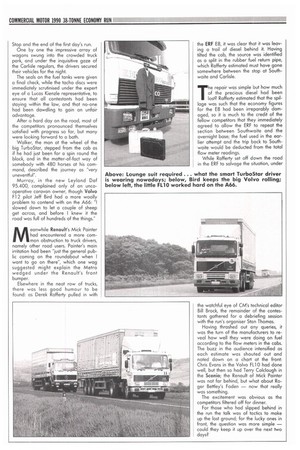
Page 68
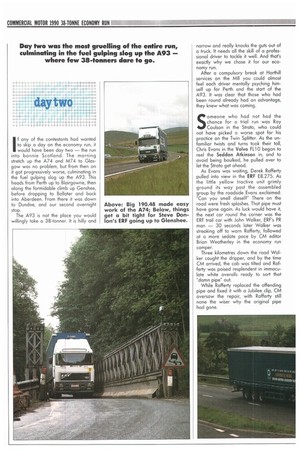
Page 69
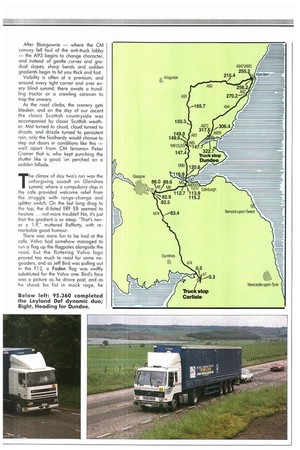
Page 72
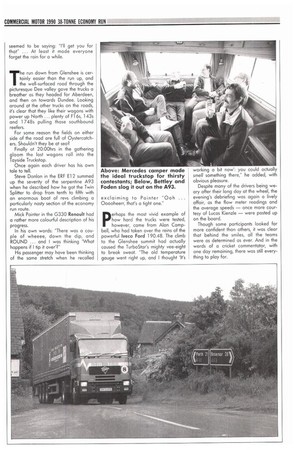
Page 74
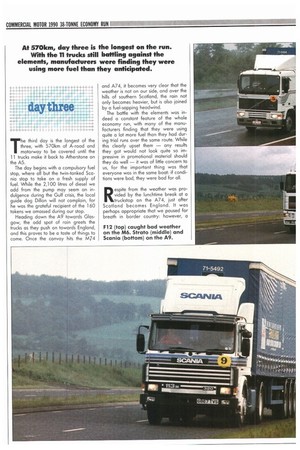
Page 76
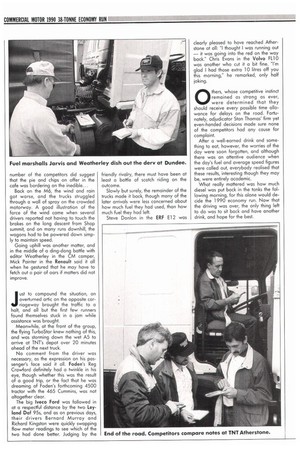
If you've noticed an error in this article please click here to report it so we can fix it.
competing in Commercial Motor's fuel economy run mustered in the Midlands. After an exacting 72-hour test the top performer would win through.
Hold ng a fuel economy run is not as simple as it sounds. The stakes are high for the manufacturers, so we had to be sure that every manufacturer's entry was, to paraphrase the famous Advertising Standards Authority yardstick, "Decent, Legal, Honest and Truthful". That meant going over each vehicle with a fine tooth-comb to ensure noone got an unfair advantage, unwittingly — or otherwise. Our rules allowed any truck to be entered, even new models not yet on sale, provided the vehicle was officially on sale at the time of publication, at the NEC Motor Show. If it wasn't available by show time, no matter whether it won in June, it would be disqualified. Moreover, any special equipment, like an aerodynamic spoiler kit, would also have to be available to the general haulier at the same time.
The economy run would be conducted along the same stringent lines as a regular CM heavy truck test, with careful tank-top-to-tank-top readings at the start and finish. There would, however, . be one noticeable difference. Rather than having CM testers at the wheel, each manufacturer would provide its own driver, plus an observer to ride in a competitor's truck to ensure that the driver kept to the speed limits and didn't dawdle unnecessarily to save fuel.
On the day before the run, the 11 competing trucks and 22 crew members converged on the Midlands as part of our pretest preparations. To include a productivity award, we first needed to know the weight of the tractor and trailer. Checking the latter was relatively easy as all were new 13.5m Crane Fruehauf curtainsiders on loan from TIP with a common weight.
Rather than trust the spec sheet, however, we weighed each combination and tractor separately at the Warwickshire County Trading Standards weighbridge having first brimmed each vehicle's tank at a nearby Mobil station. As each truck was weighed off, the curtains and doors on the TIP trailers were sealed with tamperproof lead tags so nobody could "accidentally" adjust a test load during the event. Then it was off to TNT at Atherstone for the next stage of the scrutineering process.
As each truck waited to go under the microscope the first of the stories about each team's preparation started to come to light over coffee as competitors gathered in our camper for a cuppa. Seddon Atkinson was definitely banking on experience with its driver. Roy Coulson was the man who took top honours for Seddon Atkinson back in 1983 with a Cummins-powered 401. Could he make it two out of two in a Perkinspowered Strata in 1990? The only problem was that until three days before the event the furthest Coulson had driven a Strata was 16km — seven years ago he moved from his regular driving job for Seddon into the warranty department. How did Coulson feel about it? After four hours' practice with the Strata and the Twin Splitter Roy was about to embark on his own personal trial: "I want to see if I can still do it it's a bit like riding a bike; you might get rusty but you never forget." As for Foden there were doubts as to who would actually be behind the wheel on the big day. Early on Sunday morning Foclen PR man Reg Crawford got a panic call from the wife of haulier Roger Bettley — Foden's regular demonstration driver and roadshow organiser — to say that Roger was feeling ill. A Saturday night special curry was fighting back. Crawford was "totally banjaxed". Roger's brother Stephen, an owner-driver, was quickly pressganged into driving the Tx Eagleengined 4000 Series down to Warwick, leaving Crawford to wonder which Bettley would actually be be hind the wheel on Monday. Stephen, however, seemed unworried by the possibility of having to step into the breach. Meanwhile Leyland Daf's Richard Kingston was standing in front of the company's "Mystery truck": the Leyland Daf 95.400, complete with gaffer tape over the badge. Originally planning to run with a 95.380, Kingston decided to enter the 95.400 (officially launched at the Motor Show this week) after a flying visit to Eindhoven. The 400 looked good, so they went with it, According to Kingston: "There just wasn't the time to play around. It was transported and delivered straight into Colchester for the odds and ends, and we took it over our Midlands route to get a feel of it." Having chosen the 95.400, it made sense to pick one of the other revised 95s as a stablemate, so the 95.360 was selected to form the other half of the dynamic duo.
Volva's demonstrations operations manager Jeff Bird was certainly not going to make a fuss over the company's two entries. "We always knew it would be an FL10, although we weren't sure whether we'd go with the 360 or 400 F12." In the end Volvo chose the former. The FL10 entry could hardly be called a "special". According to Bird: "It's just an old demonstrator that's been hashed and bashed about by hundreds of drivers. It's the same thing we do for press tests, put it on the demo fleet — get some miles on it: that's how you get the best results, nothing fancy.' Truck Industries' Dave Gadsden was equally sure that the latest G330 was the best bet for Rh. "We knew this was going to be the one. We had a bit of a panic coupling up to the new length trailers but we've sorted it out,' As soon as the G330 was ready, driver Mick Painter went round the route to see what lay in store and even had a video taken of the bad bits, particularly the roads up around Braemar: "The only problem I hit were caravanners, but as soon as they saw us coming they got out of the way!"
Derek Rafferty, ERF's long-serving test engineer, had a good indicator to the kind of vehicle that he should enter. "The El 2.325 Tx was an obvious choice because of the success we had with it at the beginning of the year on test with CM. We've kept exactly the some vehicle everybody has had for press tests." The other ERF was a prototype in every sense of the word, being the latest E8.27 tractor with the uprated Cummins C Series engine. Like Volvo and Renault, Rafferty took some time to look at the worst parts of the route, notably the unfamiliar Scottish section. Steve Donlon handled the El 2.
lveco Ford's mighty 190.48 TurboStar also enjoyed a preview of the route in the hands of Alan Campbell and Paul Walker. Then it was back for a final ser vice, a new set of filters "and we've given it a good wax too". Last, but not least, the Scania 113.320 tractor was another highmileage press demonstrator that had been set aside for the run. The same vehicle recently did well on our Scottish route.
In the hands of Terry Colclough much was expected of it. Back in TNT's spotless workshop each truck was pulled into the bay under the watchful eye of .group fleet engineer Alan Parker before being prodded and poked by Dave Baylis, Jim Laird, Geoff Cope, John Hodges and Roger Wood — men who had given up a Sunday to ensure fair play.
Each cab was tilted, and chassis and engine number details were taken, then fuel line connections were painted with red touch-up paint to make sure nobody tried to add a little diesel "unofficially". By late afternoon the last engine was shut down and the keys handed in to TNT's security. Then it was back to the hotel for the first evening briefing on the route and procedures for breakdown (nobody would be allowed to lay a spanner on a disabled truck without a marshall being present). Meanwhile back at Atherstone, CM photographer Peter Cramer was busy taking one last group shot of the trucks. Silting under the powerful floodlights the 11 arks looked taut and ready. But which one would finish on top? In 72 hours we would have the answer. Early on a Monday morning the crews returned to the long line-up of waiting trucks. Some drivers looked nervous, others excited, and Roger Bettley of Foden looked much better.
Our first task was to make sure each vehicle had the correct tyre pressures. Although the tyres had been checked on Sunday, the overnight break had revealed a few which were still not quite right, so with the assistance of TNT's staff at Atherstone the final adjustments were swiftly completed.
As each truck cleared the air check it was straight on to the fuel island, and the fuelling marshalls led by CM Bodybuilder editor Bryan Jarvis: the man who oversaw fuelling on the original run back in 1983, and someone used to having worried manufacturers in close attendance while he looked down the neck of the fuel tank with a dip rod.
The artics were driven up to a chalk mark next to the pump and filled to a set point using a special dipstick, which was kept well away from the contestants. As a level was agreed upon by Jarvis and the official driver, the tank cap was firmly topped off with wire and special lead Customs seals. If anybody tried to add diesel we'd know.
During the run we decided to give each competitor fixed amounts of diesel, with the final measurement taking place at the same TNT pump where they started from three days earlier. That way
there would not be individual fuel figures for each day, just an overall result for the whole three days.
At 10:30hrs the first of our contestants, the lveco Ford 190.48, was ready to roll. The most powerful trucks would go first to avoid any bunching. A last minute conflab with driver Paul Walker, a check that the in-cab phone was working, and the TurboStar was pulling out of Atherstone and heading for the M42 and the first day's 521km.
Rest stops were chosen for each day to comply with the EC hours law. On day one the first stopover was Ferrybridge services off the Al. As the first drivers pulled into the services, and soon after into the CM chuckwagon for a brew, the first on-the-road reports started coming back.
Despite a traffic census on the M62 and some strong cross winds most had a fairly leisurely drive. The majority of manufacturers had fitted their own flow meters to the trucks so they were soon comparing notes. Leyland Daf's Richard Kingston in the 95.360 was soon quizzing team member Bernard Murray on the figures for the 95.400 which seemed to be setting a good pace. "Slow down" said Kingston, only half joking. Murray, however, clearly had the productivity award on his mind.
Back on the road, the weather was sunny, but the wind was not doing anyone any favours in helping to save diesel. Along the Al up to Scotch Corner the wind on the cornfields set up patterns like ripples on water.
There were fantastic views to be hod on the tough A66 over the Pennines, but our drivers probably had other things on their minds: how to keep the revs in the green while beating the minimum average speed below which they risked disqualification.
After a brief compulsory stop for diesel at Southwaite services it was just a short trot up the M6 to the Carlisle Truck Stop and the end of the first day's run.
One by one the impressive array of wagons swung into the crowded truck park, and under the inquisitive gaze of the Carlisle regulars, the drivers secured their vehicles for the night.
The seals on the fuel tanks were given a final check, while the tacho discs were immediately scrutinised under the expert eye of a Lucas Kienzle representative, to ensure that all contestants had been staying within the law, and that no-one had been dawdling to gain an unfair advantage.
After a hard day on the road, most of the competitors pronounced themselves satisfied with progress so far, but many were looking forward to a bath.
Walker, the man at the wheel of the big TurboStar, stepped from the cab as if he had just been for a spin round the block, and in the matter-of-fact way of somebody with 480 horses at his command, described the journey as "very uneventful".
Murray, in the new Leyland Daf 95.400, complained only of an uncooperative caravan owner, though Volvo F12 pilot Jeff Bird had a more woolly problem to contend with on the A66: "I slowed down to let a couple of sheep get across, and before I knew it the road was full of hundreds of the things."
ivieanwhile Renault's Mick Painter had encountered a more common obstruction to truck drivers, namely other road users. Painter's main irritation had been "just the general public coming on the roundabout when I want to go on there", which one wag suggested might explain the Metro wedged under the Renault's front bumper.
Elsewhere in the neat row of trucks, there was less good humour to be found: as Derek Rafferty pulled in with the ERF E8, it was clear that it was leaving a trail of diesel behind it. Having tilted the cab, the source was identified as a split in the rubber fuel return pipe, which Rafferty estimated must have gone somewhere between the stop at Southwaite and Carlisle.
The repair was simple but how much of the precious diesel had been lost? Rafferty estimated that the spillage was such that the economy figures for the E8 had been irreparably damaged, so it is much to the credit of the fellow competitors that they immediately agreed to allow the ERF to repeat the section between Southwaite and the overnight base; the fuel used in the earlier attempt and the trip back to Southwaite would be deducted from the total flow meter readings.
While Rafferty set off down the road in the ERF to salvage the situation, under the watchful eye of CM's technical editor Bill Brock, the remainder of the contestants gathered for a debriefing session with the run's organiser Stan Thomas.
Having thrashed out any queries, it was the turn of the manufacturers to reveal how well they were doing on fuel according to the flow meters in the cabs. The buzz in the audience intensified as each estimate was shouted out and noted down on a chart at the front: Chris Evans in the Volvo FL10 had done well, but then so had Terry Colclough in the Scania; the Renault of Mick Painter was not far behind, but what about Roger Bettley's Foden — now that really was something.
The excitement was obvious as the competitors filtered off for dinner.
For those who had slipped behind in the run the talk was of tactics to make up the lost ground; for the lucky ones in front, the question was more simple — could they keep it up over the next two days?
If any of the contestants had wanted to skip a day on the economy run, it would have been day two — the run into bonnie Scotland. The morning stretch up the A74 and M74 to Glasgow was no problem, but from then on it got progressively worse, culminating in the fuel gulping slog up the A93. This heads from Perth up to Blairgowrie, then along the formidable climb up Genshee, before dropping to Balloter and back into Aberdeen. From there it was down to Dundee, and our second overnight stop.
The A93 is not the place you would willingly take a 38-tanner. It is hilly and narrow and really knocks the guts out of a truck. It needs all the skill of a professional driver to tackle it well. And that's exactly why we chose it for our economy run.
After a compulsory break at Harthill services on the M8 you could almost feel each driver mentally psyching himself up for Perth and the start of the A93. It was clear that those who had been round already had an advantage, they knew what was coming.
Someone who had not had the chance for a trial run was Roy Coulson in the Strafe, who could not have picked a worse spot for his practice on the Twin Splitter. As the unfamiliar twists and turns took their toll, Chris Evans in the Volvo FL10 began to reel the Seddon Atkinson in, and to avoid being baulked, he pulled over to let the Strata get ahead.
As Evans was waiting, Derek Rafferty pulled into view in the ERF E8.275. As the little yellow tractive unit grimly ground its way past the assembled group by the roadside Evans exclaimed: "Can you smell diesel?" There on the road were fresh splashes. That pipe must have gone again. As luck would have it, the next car round the corner was the ERF trail car with John Walker, ERF's PR man — 30 seconds later Walker was streaking off to warn Rafferty, followed at a more sedate pace by CM editor Brian Weatherley in the economy run camper.
Three kilometres down the road Walker caught the dripper, and by the time CM arrived, the cab was tilted and Rafferty was poised resplendent in immaculate white overalls ready to sort that "damn pipe" out.
While Rafferty replaced the offending pipe and fixed it with a Jubilee clip, CM oversaw the repair, with Rafferty still none the wiser why the original pipe had gone.
After Bloirgowrie — where the CM convoy fell foul of the anti-truck lobby — the A93 begins to change character, and instead of gentle curves and gradual slopes, sharp bends and sudden gradients begin to hit you thick and fast.
Visibility is often at a premium, and around every tight corner and over every blind summit, there awaits a trundling tractor or a crawling caravan to trap the unwary.
As the road climbs, the scenery gets bleaker, and on the day of our ascent the classic Scottish countryside was accompanied by classic Scottish weather. Mist turned to cloud, cloud turned to drizzle, and drizzle turned to persistent rain, only the foolhardy would choose to step out doors in conditions like this — well apart from CM lensman Peter Cramer that is, who kept punching the shutter like a good 'un perched on a sodden hillside.
The climax of day two's run was the unforgiving assault on Glenshee summit, where a compulsory stop in the cafe provided welcome relief from the struggle with range-change and splitter switch. On the last long drag to the top, the ill-fated ERF E8 seemed to hesitate ... not more trouble? No, it's just that the gradient is so steep. "That's never a 1:9," muttered Rafferty, with remarkable good humour.
There was more fun to be had at the cafe. Volvo had somehow managed to run a flag up the flagpoles alongside the road, but the fluttering Volvo logo proved too much to resist for some nogooders, and as Jeff Bird was pulling out in the F12, a Foden flag was swiftly substituted for the Volvo one. Bird's face was a picture as he drove past, and as he shook his fist in mock rage, he
seemed to be saying: "I'll get you for that" At least it made everyone forget the rain for a while.
The run down from Glenshee is certainly easier than the run up, and the well-surfaced road through the picturesque Dee valley gave the trucks a breather as they headed for Aberdeen, and then on towards Dundee. Looking around at the other trucks on the roads, it's clear that they like their wagons with power up North ... plenty of Fl 6s, 143s and 1748s pulling those southbound reefers.
For some reason the fields on either side of the road are full of Oystercatchers. Shouldn't they be at sea?
Finally at 20:00hrs in the gathering gloom the last wagons roll into the Tayside Truckstop.
Once again each driver has his own tale to tell.
Steve Donlon in the ERF El 2 summed up the severity of the serpentine A93 when he described how he got the Twin Splitter to drop from tenth to fifth with an enormous boot of revs climbing a particularly nasty section of the economy run route.
Mick Painter in the G330 Renault had a rather more colourful description of his progress.
In his own words: "There was a couple of wheeee, down the dip, and ROUND ... and I was thinking 'What happens if I tip it over'?"
His passenger may have been thinking of the same stretch when he recalled exclaiming to Painter "Ooh ... O000heerr, that's a tight one."
perhaps the most vivid example of how hard the trucks were tested, however, came from Alan Campbell, who had taken over the reins of the powerful Iveco Ford 190.48. The climb to the Glenshee summit had actually caused the TurboStar's mighty vee-eight to break sweat. "The old temperature gauge went right up, and I thought 'It's
working a bit now': you could actually smell something there," he added, with obvious pleasure.
Despite many of the drivers being weary after their long day at the wheel, the evening's debriefing was again a lively affair, as the flow meter readings and the average speeds — once more courtesy of Lucas Kienzle — were posted up on the board.
Though some participants looked far more confident than others, it was clear that behind the smiles, all the teams were as determined as ever. And in the words of a cricket commentator, with one day remaining, there was still everything to play for.
The third day is the longest of the three, with 570km of A-road and motorway to be covered until the 11 trucks make it back to Atherstone on the A5.
The day begins with a compulsory fuel stop, where all but the twin-tanked Scania stop to take on a fresh supply of fuel. While the 2,100 litres of diesel we add from the pump may seem an indulgence during the Gulf crisis, the local guide dog Dillon will not complain, for he was the grateful recipient of the 160 tokens we amassed during our stop.
Heading down the A9 towards Glasgow, the odd spot of rain greets the trucks as they push on towards England, and this proves to be a taste of things to come. Once the convoy hits the M74 and A74, it becomes very clear that the weather is not on our side, and over the hills of southern Scotland, the rain not only becomes heavier, but is also joined by a fuel-sapping headwind.
The battle with the elements was indeed a constant feature of the whole economy run, with many of the manufacturers finding that they were using quite a lot more fuel than they had during trial runs over the same route. While this clearly upset them — any results they got would not look quite so impressive in promotional material should they do well — it was of little concern to us, for the important thing was that everyone was in the same boat: if conditions were bad, they were bad for all.
Respite from the weather was provided by the lunchtime break at a truckstop on the A74, just after Scotland becomes England. It was perhaps appropriate that we paused for breath in border country: however, a
number of the competitors did suggest that the pie and chips on offer in the cafe was bordering on the inedible...
Back on the M6, the wind and rain got worse, and the trucks struggled through a wall of spray on the crowded motorway. A good illustration of the force of the wind came when several drivers reported not having to touch the brakes on the long descent from Shop summit, and on many runs downhill, the wagons had to be powered down simply to maintain speed.
Going uphill was another matter, and in the middle of a ding-dong battle with editor Weatherley in the CM camper, Mick Painter in the Renault said it all when he gestured that he may have to fetch out a pair of oars if matters did not improve.
Just to compound the situation, an overturned artic on the opposite carriageway brought the traffic to a halt, and all but the first few runners found themselves stuck in a jam while assistance was brought.
Meanwhile, at the front of the group, the flying TurboStar knew nothing of this, and was storming down the wet A5 to arrive at TNT's depot over 20 minutes ahead of the next truck.
No comment from the driver was necessary, as the expression on his passenger's face said it all. Foden's Reg Crawford definitely had a twinkle in his eye, though whether this was the result of a good trip, or the fact that he was dreaming of Foden's forthcoming 4500 tractor with the 465 Cummins, was not altogether clear.
The big lveco Ford was followed in at a respectful distance by the two Leyland Daf 95s, and as on previous days, their drivers Bernard Murray and Richard Kingston were quickly swapping flow meter readings to see which of the two had done better. Judging by the
friendly rivalry, there must have been at least a bottle of scotch riding on the outcome.
Slowly but surely, the remainder of the trucks made it back, though many of the later arrivals were less concerned about how much fuel they had used, than how much fuel they had left.
Steve Donlon in the ERF El 2 was
clearly pleased to have reached Atherstone at all: "I thought I was running out — it was going into the red on the way back." Chris Evans in the Volvo FL10 was another who cut it a bit fine. "I'm glad I had those extra 10 litres off you this morning," he remarked, only half joking.
0 thers, whose competitive instinct remained as strong as ever, were determined that they should receive every possible time allowance for delays on the road. Fortunately, adjudicator Stan Thomas' firm yet even-handed decisions made sure none of the competitors had any cause for complaint.
After a well-earned drink and something to eat, however, the worries of the day were soon forgotten, and although there was an attentive audience when the day's fuel and average speed figures were called out, everybody realised that these results, interesting though they may be, were entirely academic.
What really mattered was how much diesel was put back in the tanks the following morning, for this alone would decide the 1990 economy run. Now that the driving was over, the only thing left to do was to sit back and have another drink, and hope for the best.






















































































































































































